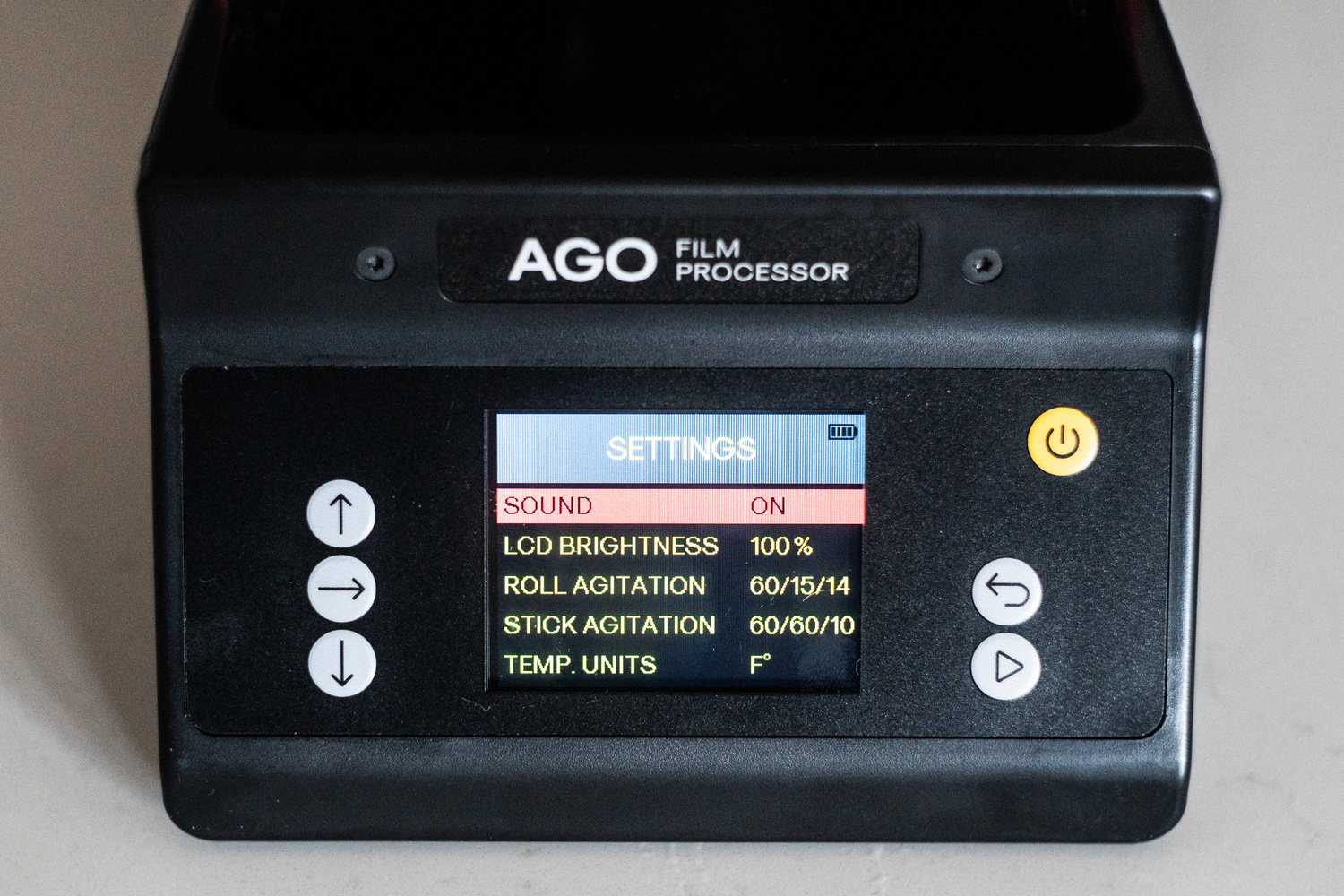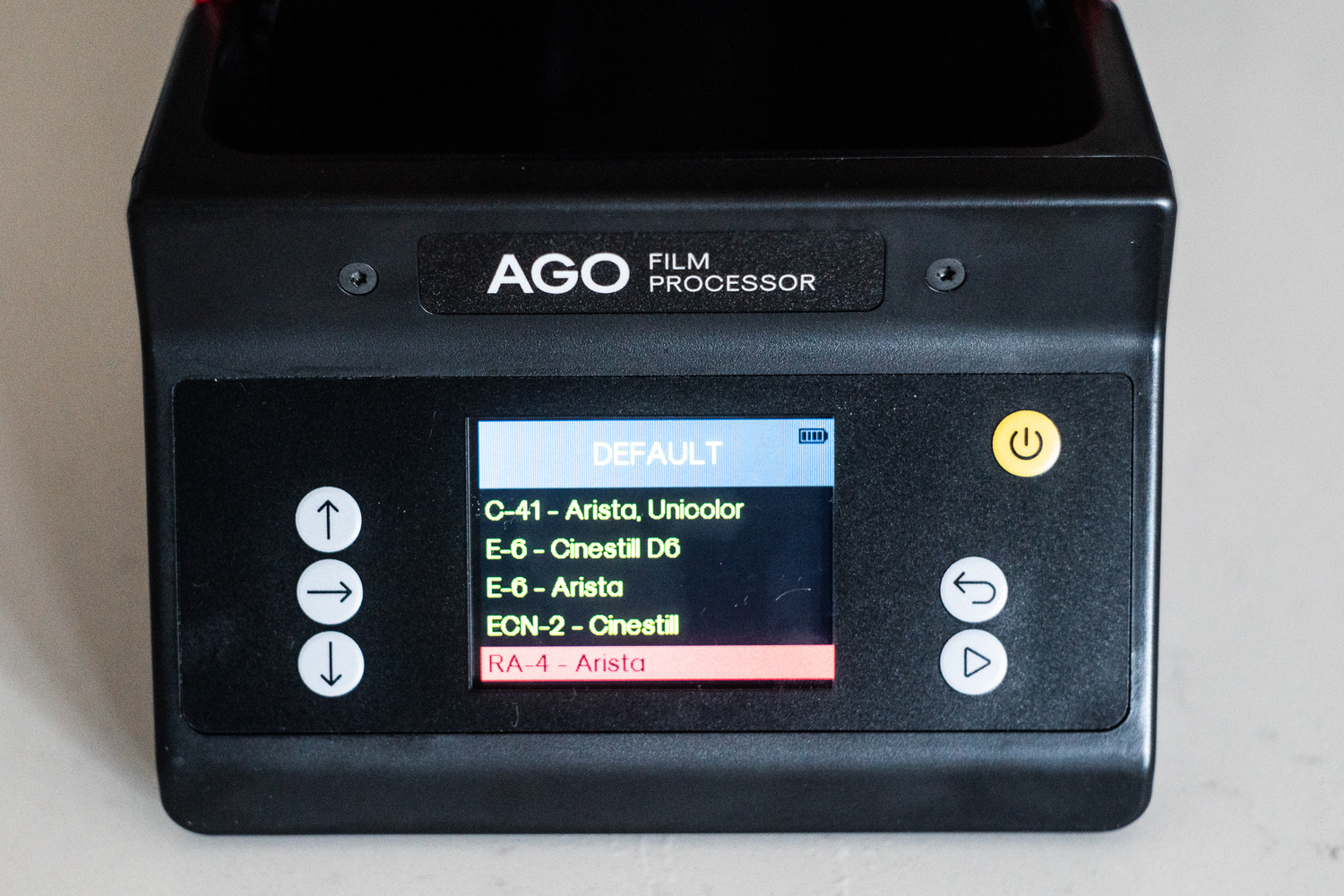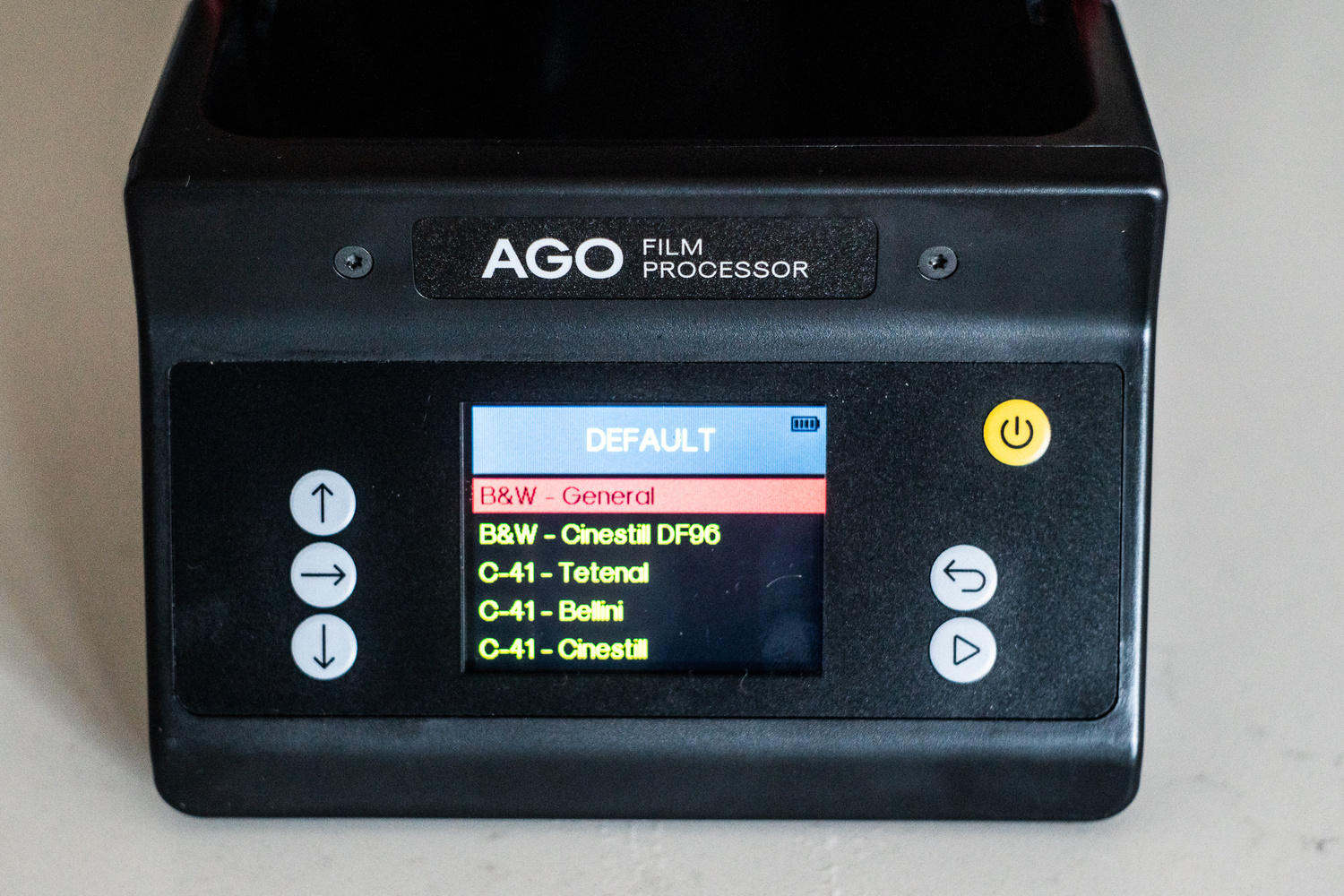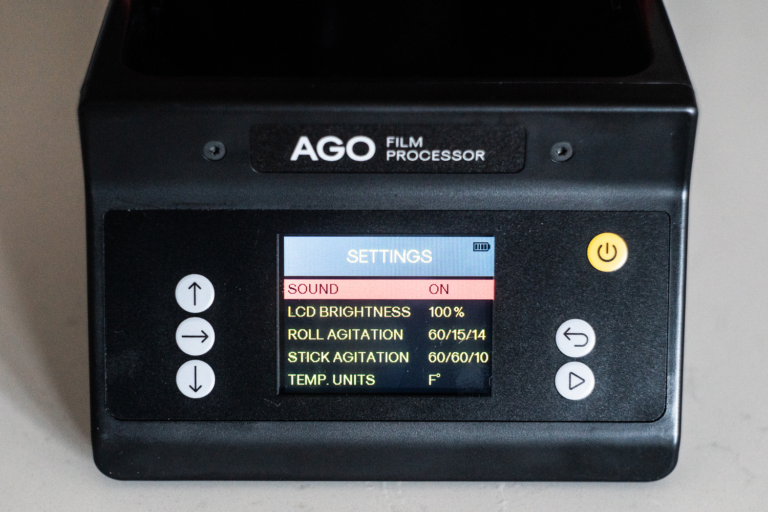As soon as I cracked open the box from Vintage Visual and laid eyes on the AGO Film Processor, six small yet all-too-familiar words leaped from my brain in a gush of envy: “Why didn’t I think of that?”
The concept behind the AGO Film Processor is simple. At the end of the day, the AGO is an automatic rotary agitator for developing black and white as well as color photographic films.
That’s fine, but it’s certainly nothing new. A host of agitators are and have been on the market for decades.
What makes the AGO completely unique is that it is a rechargeable, standalone film development agitator that makes use of the legendary Paterson daylight developing tank.
…and it dynamically adjusts the processing time based on the real-time temperature of the chemistry…
…and comes loaded with a multitude of development presets based on some of the more popular film and paper processes on the market today.
In fact, it will be no small task to keep this review of the AGO Film Processor within any manageable length. I’ll do my best, and that’s all Ansel Adams ever really asked of us anyway.
I’ve made a handy-dandy video reference to accompany this written review of the AGO Film Processor. So, as you read along, feel free to check out the video to see many of these features in action.
Tanks a lot
That’s right, friends, the AGO is designed to work with that old Paterson tank you’ve got stashed away in the closet.
Paterson Super System developing tanks are arguably the gold standard in development tanks for both hobbyists and professional film folk.
One of the most appealing things to me about the design of the AGO is how it can use literally any size Paterson developing tank currently on the market in 2024. From the smallest single-reel tank (PTP114) to the laughably large 8-reel (PTP118), the AGO snugly fits to the rim of the Paterson tank by means of a hard rubber gasket.
The agitator of the AGO mates with the center of the reel column (the column must be installed) and thus agitates the film or paper within the tank. This agitation is completely programmable in terms of direction and duration and can also be disabled completely for vertical stand development.
More on this in the next section.
It’s worth noting that using the AGO requires a slight augmentation to the funnel portion of the Paterson tank system. Three holes must be drilled into the side of the funnel to accommodate the introduction of the development liquids. Vintage Visual includes a pattern for the drilling with each AGO processor or, alternatively, can also supply a pre-drilled funnel at additional cost.
Admittedly, drilling into my beloved Paterson tanks in any way horrified me. Luckily, I was supplied with a pre-drilled funnel.
That being said, it was a slight comfort knowing that Vintage Visual insists that the drilling of the holes in no way compromises the daylight functionality of the tank should it be used without the processor attached.
Note that the AGO also works with older Paterson tank columns by way of an adapter, which is included with the purchase of the processor. Vintage Visual also offers a free STL file download to 3D print your own adapter.
About That Wheel
I mentioned earlier that the likely goal of Vintage Visual was not to introduce some revolutionary new film processor. Instead, I feel the AGO addresses the key factors for consistent film development: temperature control, agitation, and timing.
It’s time for a breakdown of how the AGO Film Processor handles these three key elements to help (mostly) fool-proof the film development process.
Temperature Monitoring
See this little shiny, metallic rod protruding from the rear of the AGO? That’s the thermometer.
This thermometer keeps track of the chemical temperature in the developer stage, which is an important factor when developing film, especially color films, to ensure a more accurate development.
Unless one is using a dedicated processing unit with a built-in, self-regulated heating bath, it is quite difficult to maintain a constant chemical temperature throughout the development process.
Instead of featuring an onboard heating unit, the AGO dynamically senses the chemical temperature, then either lengthens or shortens the development time throughout the entire process.
For example, during one of my medium format C-41 developments, my chemicals cooled considerably. The AGO automatically lengthened the development to compensate with no input from me. You can see this in real time in the video portion of the review.
Agitation Control
This is not a primer on film processing, folks. As such, know that what I’m about to touch on has been distilled down into a manageable nugget.
No matter if you’re developing color or black and white film or paper, agitation plays a large role in overall contrast and development time, as well as a few other arguable characteristics.
Simply put, as the film or paper develops, the chemicals closest to the emulsion become exhausted.
Agitation…well…agitates the chemicals so that the exhausted chemicals are constantly replenished. The direction and duration (more so the latter than the former) also affect the outcome of development. Again, this is a highly basic explanation.
For our purposes, just know that with the AGO, the agitation is programmable.
The agitation system of the AGO can be set to turn either clockwise or counterclockwise, and for a set amount of time in either direction. It can also be switched completely off to facilitate something known as “stand development.”
We won’t go into stand development right now. You’re welcome.

With programmable agitation, especially when the AGO is positioned vertically, it’s possible to program quite nuanced stand development protocols.
Preprogrammed Development Protocols
One of the greatest strengths of the AGO film processor is its pre-programmed film development protocols—the ability to “set it and forget it.”
Well, maybe not forget it, but close.

Depending on your point of view, this makes the AGO extremely attractive for beginners hoping to flatten their learning curve (especially for color processing) or for the more seasoned among us who want an easy way to batch develop large crops of film as consistently as possible.

As of this writing, the AGO film processor supports the following chemical developing processes as pre-programmed presets:
- Black and white film
- C-41 color negative
- E-6 color positive (reversal)
- ECN-2 color negative
- RA-4 color reversal (paper)
The AGO also comes programmed with brand-specific presets for a handful of popular color developers, such as Arista/Unicolor, Cinestill, Flic Film, JOBO, ADOX, Tetenal, and Bellini.
Currently, the firmware for the AGO stands at version 6.5.0. This firmware update saw the introduction of a more streamlined web interface for updating firmware as well as for creating additional development presets.
The development program manager is accessed via the AGO’s built-in Wi-Fi.
Film and Paper
As you’ve likely guessed from the list of development programs, the AGO develops both photographic color/B&W film and photographic color/B&W photo paper.
For 35mm (135) and medium formats (120/220), the standard auto-load Paterson reels work perfectly and are what the AGO was designed to be used with for development.
The AGO is also more than capable of developing larger film formats, up to 8×10.
During this review, I developed a few sheets of 4×5 film by way of my trusty MOD54 six-sheet development holder, which worked perfectly. Vintage Visual also offers a proprietary 4×5 film holder of their own.
For larger formats such as 8×10 film and paper, the AGO makes use of a perforated development cylinder.
In truth, this development cylinder might merit its own standalone review, as tank development reels/holders for larger formats are not overly common. The development cylinder for the AGO seems to be 3D-printed and quite robust.
It works for both film and paper, but be ever mindful that the emulsion is always faced inward when loading. You can see the loading process in the video portion of this review.
One note to my fellow radiographic film shooters, or anyone who happens to be using double-sided emulsion film or paper: the pentagonal holes in the development cylinder will leave outlines on the emulsion of your film or paper. As such, I would not recommend using the 8×10 cylinder for those mediums.
Power and Form Factor
I’ve saved my favorite part about the AGO Film Processor for last. Or, well…next to last.
When you first see the AGO, one would be forgiven for having a feeling of “Is this really it?”
Yes, the AGO is actually so compact that I initially thought I was missing something. The overall form factor is roughly the size of a DSLR camera with, let’s say, a 24-70mm lens attached, give or take, and it’s much more compact than I was expecting.
Compared to my Beseler rotary base, the AGO is downright tiny.
Not only is the footprint of the AGO delightfully small, but the fact that it is a self-contained unit is mind-blowing to me. That is, the AGO Film Processor is rechargeable.
Using a standard USB-C charging cable (and appropriate power source), the AGO runs all by itself—no cords, no cables. This makes it extremely appealing for stowing away for on-site development sessions or in locations where space comes at a premium.
The ability to recharge the unit in one place and use it in another would have been an absolute dream for me not even five months ago when I was a full-time photographic dirtbag living and developing/printing exclusively from the road in my mobile darkroom.
In addition to this, seeing as the AGO can use a smaller volume of developer and fixer due to its horizontal rotary configuration, I could have saved so much of my precious water, allowing me to stay in the field longer between restocks.
And if you’re worrying about the battery life of the AGO, I fully charged the unit upon arrival and used it for this review to develop, fix, and rinse three rolls of 120 film, three sheets of 4×5 film, and two sheets of black and white photo paper.
After all that, the battery level still displays 100% charge. This usage also includes the time I kept the machine “ON” for photos and while getting to know the menus.
A Few Negatives
Along with the good always comes the bad. Fortunately, many of the sparse negative aspects I encountered while using the AGO Film Processor from Vintage Visual were few and far between.
First things first: I do wish the bottom of the AGO was rubberized or anti-slip. Using it on a polished (dry) countertop was perfectly fine, but the entire processor and tank easily slid around the surface.
A set of four rubber feet would not only help to make the processor more stable but also elevate the AGO above any errant spills that may occur. On that note…
I found it difficult to pour chemicals into the mouth of the AGO processor with any considerable speed without sloshing them out of the processor. This may well have been a result of my own impatience or poor technique, but I feel a steeper ramp angle for the AGO could help solve this.
The USB-C charging port of the AGO is wide open, with no cover.
This has been mentioned by other reviewers. I have learned that Vintage Visual is addressing this issue and will hopefully be including some type of cover in subsequent builds of the AGO. In the meantime, cheap USB-C cell phone charging port covers would work perfectly to protect the charging port of the AGO.
Parting Thoughts
I joked with my contact at Vintage Visual that I desperately wished I had discovered the AGO Film Processor a couple years…ago (puns, right?).
As a traveling, film-shooting enthusiast venturing into strange and unusual places with my cameras, having something onboard that would have helped me produce better negatives more consistently, all while using less chemistry, less water, and less electricity, would have been absolutely wonderful.
Here are a handful of photographs developed using the AGO Film Processor from Vintage Visual.
For me, I’ve settled into a semi-permanent living situation in central North Carolina. However, my needs have not changed in terms of film processing.
I still would like to use less water, less electricity, make my development chemicals last longer, and, let’s face it, take a little bit of human error out of the equation.
And I feel this sums up exactly the goals the folks at Vintage Visual are trying to achieve with the AGO Film Processor: accuracy and convenience.
For me, the AGO will never completely replace my habitual film and paper development. I’ll always tray-develop my 8×10 and 11×14 negatives. I’ll always tray-develop my cyanotypes and black and white paper. I likely won’t be breaking out the AGO for single rolls of black and white 120 or 135.
But for my color work? I will use the AGO each and every time. The ability to keep track of the chemistry temperature and adjust accordingly is brilliant.
For five-roll batches of black and white medium format? I’ll absolutely set up the AGO for the efficiency factor alone. I make my own developers, and to be able to use a third less (or even less than that) is an exercise in common sense.
So, the burning question might well be this: who is the AGO for?
The answer to this lies in the realm of blurred subjectivity. The AGO Film Processor is not a cure-all for each and every development issue encountered by the beginner or professional film shooter, but it does come close.
Like all things non-digital practitioners use, the AGO is nothing more than a tool, and each tool has a particular time and place for its application.
The AGO will now be shoved in my car for those week-long camping trips with the Hasselblad. I’ll be using it for my RA-4 papers every single time. It won’t be something I use every day, but I can already tell I’ll be glad to have it when the need arises.
Have you used the AGO Film Processor from Vintage Visual? Do you have an opinion on whether automated film processing is good or bad? As always, I’d love to hear your thoughts down in the comments.
